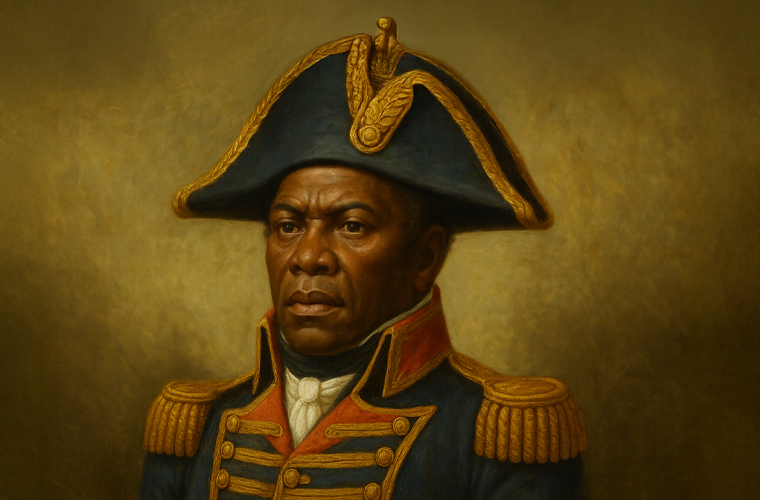Henry Christophe, born into slavery on Grenada, rose through sheer determination to become a pivotal figure in Haiti’s fight for independence. Illiterate and unschooled, he learned from experience, channeling his ambition into eradicating slavery and building a strong Haitian nation. His journey from a slave boy to King Henry I was marked by resilience, leadership, and an unyielding commitment to his people.
Christophe’s childhood was turbulent. At seven, his plantation owner sold him to a Negro mason as an apprentice, seeking to profit from his energy. Unwilling to be bound, Christophe fled, stowing away on a ship to Saint Domingue (modern Haiti). By twelve, he served a French naval officer, polishing boots and serving meals. This role took him to America, where he fought in the Siege of Savannah during the American Revolution. Returning to Haiti, he was sold again, this time to a free Negro hotel owner. Starting as a stable boy, Christophe worked his way up to cook, waiter, and billiard marker, saving enough to buy his freedom.
As European powers—Spanish, French, and English—vied for control of Saint Domingue, slaves rebelled under Black General Toussaint Louverture. Christophe joined Toussaint’s army, displaying early leadership. By 1802, Toussaint had repelled the Spanish and British, declaring himself Governor-General and naming Christophe a general and military governor, alongside Jean-Jacques Dessalines and Alexandre Pétion. When Toussaint established a government without Napoleon’s consent, the French sent General Charles LeClerc to restore control, with an underlying threat to reinstate slavery.






LeClerc’s emissary insulted Christophe by offering honors to betray Toussaint and surrender Cap François. Loyal to his commander, Christophe refused, vowing to burn the city if the French landed. When LeClerc’s 15,000 troops arrived, Christophe fulfilled his promise, torching Cap François, starting with his own home, as French forces stormed ashore. The war with France intensified, and after heavy losses, Christophe negotiated on Toussaint’s behalf. LeClerc agreed to abolish slavery, but Toussaint was arrested and exiled. After LeClerc’s death from yellow fever, Dessalines led Haiti to independence on January 1, 1804, renaming the island of Saint Domingue as Haiti.
Post-independence, tensions arose between black and mulatto leaders. After Dessalines’ assassination in 1806, Christophe, at 40, was elected President of Haiti, governing the north, while Pétion established a rival government in the south, sparking civil war. In 1807, Christophe became President of the northern State of Haiti, with Pétion leading the Republic of Haiti in the south. Christophe’s ambition drove him to strengthen his territory. He declared Catholicism the state religion, banned divorce, and protected foreign trade with the U.S. and Britain. To create a currency, he monopolized gourd plants, trading gourds for coffee berries, which he sold abroad for gold, establishing the gourde as Haiti’s currency.
In 1811, to counter French threats, Christophe’s advisors proposed that he become king. He embraced the title, crowned as “Henry I, by the Grace of God and the Constitutional Law of the State, King of Haiti,” on June 2, 1811, in a cathedral built for the occasion. He renamed the capital Cap Henry and established a hereditary nobility, a Catholic hierarchy, and a strict dress code for his court. King Henry I transformed northern Haiti. His Code Henry mandated agricultural work, with structured hours and worker protections, including profit-sharing and medical care. He held weekly public audiences to hear petitions, ensuring swift responses. Christophe controlled key resources like cattle and sugar, amassing wealth for himself and the nation. He built seven palaces and 15 chateaux, boosting Haiti’s economy.
Recognizing the need for expertise, Christophe offered citizenship to white men marrying Haitian women and settling in Haiti. Education was a priority: he founded five national boys’ schools, teaching English, French, and trades, and later opened girls’ schools to counter voodoo’s influence. He also established a royal college and appointed Dr. Duncan Stewart to oversee public health, equipping hospitals with strict patient discipline measures. Christophe’s authoritarian style defined his reign. He enforced civil marriages, punished theft with death, and personally disciplined perceived laziness with his silver-topped cane. Even priests faced his wrath; one was jailed for tardiness at Mass. His rigid rule alienated some, and on August 15, 1820, a stroke left him paralyzed. Despite his clear mind, rebellion brewed. Unable to quell the unrest, Christophe shot himself on an October evening in 1820.
As looters ransacked his palace, loyalists buried his body in lime, unable to dig a proper grave. In 1847, Christophe was reinterred in a concrete tomb at the Citadel La Ferrière, a testament to his complex legacy as a liberator, builder, and autocrat who shaped Haiti’s early history.

